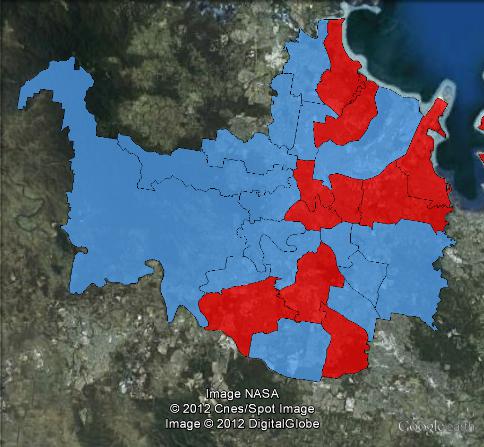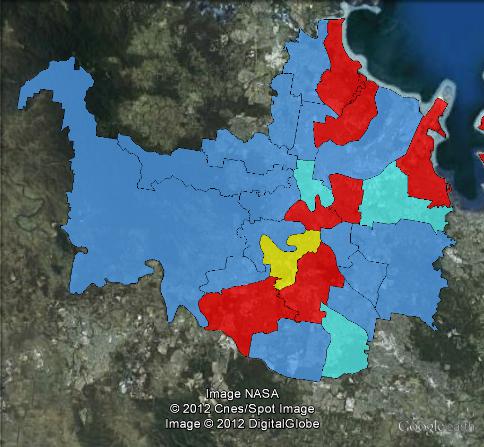Brisbane City Council stands out from all other local government in Australia. Unlike all other capital cities, Brisbane is governed by a single local government, one that covers approximately one million people.
Brisbane elections are more like state elections than most local council elections, particularly in other capital cities. Brisbane’s city council is elected by twenty-six single-member wards. These wards are only slightly smaller than a state electorate. The Council is led by a Lord Mayor who is directly elected.
This stands Brisbane apart from all other councils in Australia. While most other Queensland councils have a similar electoral system, their size doesn’t compare to Brisbane.
In many ways the City of Brisbane resembles a big American or Canadian city in the way that it is governed: large wards elected without proportional representation, a single government with a large budget and mandate, and a directly elected Mayor. Brisbane City elections are also dominated by political parties: in contrast most Australian council elections are dominated by independents, with political parties only dominating some urban councils in Sydney and Melbourne.
The Lord Mayor of Brisbane also has by far the biggest individual mandate for any single-member elected position in Australia. Over 500,000 people voted in the Brisbane mayoral ballot on Saturday. In comparison, approximately 90,000 people vote in each electorate at a federal election. Only Senators representing mainland states have more constituents, and they share those constituents with eleven other Senators.
The LNP’s Campbell Newman won the Lord Mayoralty off the ALP in 2004, with 52.5% of the two-candidate vote, but the ALP maintained a majority of councillors. In 2008, Newman was re-elected with a swing of over 13%, with the LNP gaining control of the council. Newman resigned as Lord Mayor in 2011 after he was elected as Leader of the Liberal National Party on a state level, and he was succeeded as Lord Mayor by Graham Quirk.

The overall result on Saturday wasn’t dramatic. It was a big win for the LNP, but not quite as dramatic as the massive wipe-out that the ALP suffered at the March state election. The result also demonstrated that Brisbane voters clearly are able to differentiate between electing their local councillor and voting for a Mayor.
In the Mayoral ballot, Liberal National incumbent Graham Quirk won with a two-party result of 68.3%. This was a swing of over 2% to the LNP compared to Campbell Newman’s second big win in 2008.
When Newman had first won the mayoralty in 2004 he only won a majority in 12 of 26 wards. In 2008, he won all 26. In 2012, Quirk won a majority in 25 wards, with the ALP eking out a majority in the southwest Brisbane ward of Richlands.
The Greens’ candidate, Andrew Bartlett, won 10.7% of the vote, a swing of 2.3% compared to 2008. The Greens gained a swing in all but two of the wards. While this is a substantial swing compared to 2008, it was only a 0.6% swing compared to Drew Hutton’s 10.1% result in 2004.
The result was quite different when it comes to the wards. Overall the results were:
- Liberal National – 56.8% (+4.2%) – 18 wards (+2)
- Labor – 32.3% (-5.0%) – 7 wards (-3)
- Greens – 8.5% (-1.3%)
- Others – 2.4% (+2.1%) – 1 ward (+1)

The LNP maintained their majority on the council with a swing towards them. The LNP gained the ALP’s wards of Central, Doboy and Karawatha. The LNP lost the ward of Tennyson to independent ex-LNP councillor Nicole Johnston.
The Greens vote on the surface went down, but this is entirely due to a reduced number of Greens candidates. In 2008, the Greens stood in 23 wards. In 2012, the Greens only stood in 18 wards. When comparing the vote in those 18 wards where the Greens stood in 2012, the Greens vote increased by 0.02% – effectively the same result.
Overall this was a decisive endorsement of the Liberal National Party, with a very large majority for Graham Quirk in the mayoral vote, and a very solid LNP majority on the council.



The Greens poor showing (fewer candidates, static vote overall) may be due to the ECQ ruling that candidates in the state election could not nominate for local council elections, because the state election results were not finalised.
The Greens are less able to draw on a large pool of talent for candidates, and a number of quality state candidates were probably lined up to run in the local elections. At least one strong candidate was a paper candidate for the state election, saving their energy for the local campaign.
Another possibility is volunteer burnout so close to the state election – once again, the Greens are unable to call on as large a pool of volunteers as major parties, even though they require more of volunteers, as they generally lack sufficient budget even for Australia Post delivery of campaign materials.
That, and having to divert energy to the South Brisbane by-election, which is one of the Greens ‘best chances’ in Queensland.
It’s worth pointing out that the Greens came a distant second in Pullenvale and Walter Taylor wards (rock solid LNP, just like the north shore Sydney seats in the NSW election).
Also, check out the variability of swings. 25% to LNP, 16% to Labor, and everything in between. Three wards swung to Labor; The Gabba is more of a Green-to-Labor swing (Drew Hutton ran there for the Greens in 2008), but the other two (Moorooka and Richlands) are unexplainable if you’re not from there. If you apply ward results to state seats (since they roughly overlap) you get Yeerongpilly being safer for Labor than South Brisbane. The list for them goes like so (margins and swings):
Northgate 0.8 (-0.7)
Wynnum Manly 1.6 (-7.4)
Deagon 6.3 (-1.6)
Morningside 6.6 (-5.0)
The Gabba 8.9 (+6.1)
Moorooka 11.1 (+7.0)
Richlands 20.2 (+16.2)
Those seven wards correspond roughly to the state seats of Nudgee, Lytton, Sandgate, Bulimba, South Brisbane, Yeerongpilly and Inala (in that order). Labor only won two of those in March, and Inala is the only one you could really call safe. If you think that list of swings is confusing, it only gets stranger if you look at all wards together. No real pattern to it at all.
Other elections you might be interested in looking at: Alberta (Canada), where left-wing parties have never held govt in over a century and the Tories’ most recent challenge was from a Bob Katter type party; and a few states of Germany (either last week or next week) which have the complicated politics you’d expect from a country that doesn’t freak out at the prospect of coalition governments. Specifically the Pirate Party has been doing well, and the FDP (libertarians) have been getting thumped. One state had an early election due to a coalition of conservatives, libertarians and greens falling apart; another seems to have had the main two parties kinda running together as a grand coalition, as it’s the only way either can form govt without the Left Party. (Comparable to Saskatchewan in Canada, where the Conservatives and Liberals merged to fight the NDP.)
The massive swing towards Labor in Richlands ward can be explained by the LNP having run a very good candidate with a vietnamese background in 2008 who gained a massive swing and cut into the ALP’s margin.
Comments are closed.